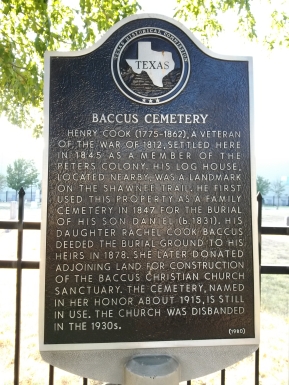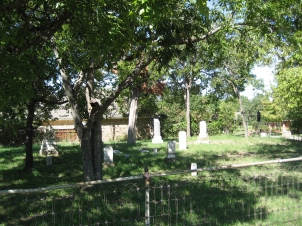For me, Texas Historical Markers inspire a great deal of awe and excitement. They do not have to mark a significant moment in history to catch my interest. Sometimes the mundane, little known events and locations can be just as fascinating as the more significant, well-known ones. History has occurred everywhere, and the smallest moments recorded are often the ones that provide the most significant connections to the past. They are stories of regular people’s lives; the kind of people we can more easily relate to.
David McCullough has said:
History is about people. History is human… You have to get to know the people. You have to get inside their lives.
So, when I stumble upon a state historical marker I get excited, but that thrill is heightened when the marker is there to mark an old cemetery. I stumbled upon such a pairing this past weekend.
On the northern side of The Shops at Legacy in Plano, Texas, there is a hill surrounded by an iron fence where inside lies the remains Henry Cook, a veteran of the War of 1812, and a member of the Peter’s Colony. Braccus Cemetery, named after Cook’s daughter’s married name, was founded by Cook when he buried his son there in 1847. A Texas Historical Marker provides a brief history of the location.

The cemetery was not my reason for going to The Shops at Legacy, I did not even know it was there. I went because I had only been in the area two times before, briefly, and wanted to take a more in-depth look around. It was a pleasant surprise to find.

Cemeteries offer something special that many historical sites do not. Historical sites can be impacting places to visit if you allow yourself to fully comprehend and reflect on what occurred in the area. Yet, in most cases the people who caused, played a part in, and/or simply experienced these occurrences cannot be found there.
While a cemetery is not always the host to a notable historical event, it does provide the resting place of the bodies of those who had lived those events. It is one thing to walk the ground of an historical site, but a cemetery can be significantly more profound since the remains of the men, women and often children who lived it are a few feet below the ground where you stand.
Some smaller cemeteries can be found in the most unlikely places. The Riley and Warner cemeteries in Carrollton, Texas are two examples of small cemeteries, not much bigger than a house lot, and are found in the middle of neighborhoods. They are an odd sight. You have a series of houses that are unexpectedly interrupted by a little hill capped with a fence and old native trees. Mixed within are grave markers more than a century old.


Perhaps the title “Historical Cemeteries” is a bit inappropriate. There are those that are declared official historical sites, but in truth, all cemeteries are historical, aren’t they? They contain the remains of people who have lived in a different time. Their bones may be all that remain, but consider this: those bones are what carried their bodies and supported them as they lived through all the events we are taught about, and many more that we are not. Their bones are the most profound connection to our past.
The cemeteries in New England age fascinating. History leaps off the markers, as the carvings often remain intact on slate vs stone.
LikeLiked by 1 person
I recently visited Delaware and visited an old cemetery in Lewes. Beautiful markers there. It seems to be an art form characteristic that will be largely missing in our era.
LikeLiked by 1 person
Unfortunately, I think you are right.
LikeLike